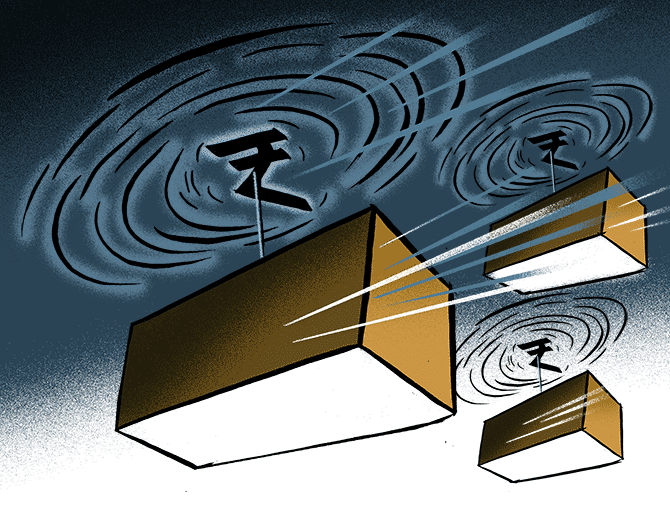 | « Back to article | Print this article |
Experts said the new framework has ensured that the focus has moved to creditor protection from debtor protection.
Illustration: Dominic Xavier/Rediff.com

Promoters of any large account in which the banking sector had an exposure of Rs 2,000 crore and above were in for trouble if they did not settle their dues soon, said experts.
The impact on banks in terms of bad debt numbers and provisioning will remain elevated.
Revising the stressed assets’ framework, the Reserve Bank of India (RBI) on Monday said these accounts, even if under restructuring, should be put through a resolution plan if the accounts were in default.
If an account is in default with one bank, other lenders in the consortium will have to try and make the account good.
Otherwise, the account could be classified as a stressed asset later, experts said, requiring high provisioning. But more clarification on this would be required, they said.
Bankers said considering most accounts under restructuring have defaulted in the past, the new framework would force these accounts to the resolution path.
However, the loans would have to be re-rated again.
This could be bad for the promoters because of two reasons.
One, if the account is in default, a resolution plan will have to be implemented within 180 days from March 1.
If no resolution is found, the account has to be referred to the insolvency court.
Second, even if one bank in the consortium objects to the resolution, the account will be subject to insolvency proceedings directly.
In an insolvency proceeding, a promoter cannot bid unless he has cleared his bad debt. This is akin to losing control of the firm.
“There is a lot of incentive for banks and promoters to find a resolution before the matter moves to the IBC,” said Ashish Chhawchharia, partner, restructuring services, Grant Thornton.
“If it goes to court, there is no certainty if the promoters will remain in the company, and the haircut banks will have to take,” he added.
This will improve recovery by banks, but lenders may have to grapple with rising provisions in the short term.
Experts, however, argued that banks had already made provisions for stressed assests.
The rules also tighten the screws on some private banks that had delayed the resolution process, bankers said.
Some of these lenders have also raised objections to resolution plans from the joint lenders’ forum, to avoid classifying an account as a non-performing asset (NPA).
Banks had allegedly used the earlier framework extensively to hide their bad debts, instead of opting for resolution.
Former RBI governor Raghuram Rajan had termed this as a “perverse incentive”.
For example, such an account can get at least 18 months if rejigged under strategic debt restructuring (SDR).
“A lot of the processes were not functioning well because lenders would either not come for meetings, or those attending the meetings did not have the authority to take decisions,” said Aashit Shah, partner and chair of financial services at corporate law firm J Sagar Associates.
“Some lenders would sign up for the restructuring arrangement, some would not. This resulted in a lot of uncertainty,” he added.
Experts said the new framework has ensured that the focus has moved to creditor protection from debtor protection.
The new regime gives promoters 180 days to resolve the issue with banks.
If they are unable to, the case moves to court and insolvency proceedings, where the creditors have the say.
According to CRISIL Ltd no incremental slippage would be created now.
The gross NPA ratio in the banking system would rise to 10.5 per cent by March, from 9.5 per cent now, and might peak at around 11 per cent in fiscal year 2019.
The stressed loans in the system might not rise beyond 14 per cent of loans, but the framework, through improved recovery, would aid banks.
Krishnan Sitaraman, senior director-financial sector ratings at CRISIL, said: “This framework enhances reporting standards, and improves the monitoring of stressed assets on a weekly basis.
"This shows a greater focus and effort by the RBI and government to resolve the bad debt mess in the system.”
The framework, though, could work as a boon for the bond market, as banks might not want to dispense fresh credit and might engage in lazy banking by investing in bonds, said Soumyajit Niyogi, associate director of India Ratings and Research.